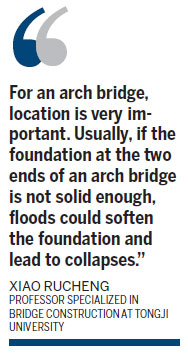Construction not at fault in bridge collapse: Official

Officials on Monday denied that a bridge in Hunan province collapsed on Sunday because of poor construction.
The 120-meter three-arch stone bridge that connected two townships in Pingjiang of Central China's Hunan province collapsed on Sunday morning after one of its piers was hit by three sand-dredging boats flushed downstream by flooding.
Nine people fell off the bridge, and as of Monday evening six were still missing.
Some news reports quoted local villagers as saying that the bridge was not reinforced with steel bars, implying the builders might have cut corners to save costs.
A publicity official with the Ministry of Transport said on Monday that the initial investigation by the provincial transport department does not suggest that the collapse was caused by poor construction quality.
"The bridge is a stone bridge with arches to support it. Not seeing steel bars on the site is natural," said the official, who spoke on condition of anonymity.
The bridge was built in 1998. Inspections organized by the ministry last year showed that it was in good condition. The bridge was not among the 4,333 dangerous bridges found in Hunan province, the officials said.
"Before it was hit by the sand-dredging boats and fell apart on Sunday morning, the bridge has been impaired by floods on Saturday," she said.
According to the local meteorological bureau, Pingjiang was hit by rainstorms between 1 and 7 am on Saturday, which triggered flash floods.
The county government closed the bridge to traffic on Saturday and stationed workers there after it noticed the structure had been damaged.
It blamed some villagers for ignoring orders to stay off the bridge.
There has been a string of bridge accidents in recent years. Last year, two bridges collapsed in two consecutive days.
One person was killed and 22 injured on July 14, when a bridge in Fujian province collapsed. Less than 20 hours later, another bridge in Hangzhou of Zhejiang province partially collapsed.
Authorities blamed overloaded trucks for the collapses.
However, many netizens were not convinced and argued that most of the bridges that had collapsed were built in recent years, while some much older bridges have withstood floods and overloaded vehicles.
The Wuhan Yangtze River Bridge, built in 1958, has been hit by boats more than 10 times, but has remained in good shape and is still in use.
Netizens also cited the Zhaozhou Bridge in Hebei province, a large one-arch stone bridge built between 595 and 605, making it more than 1,400 years old.
Xiao Rucheng, a professor specialized in bridge construction at Tongji University in Shanghai, said that the Zhaozhou Bridge's longevity is due to good-quality construction and the geological conditions of its location.
"For an arch bridge, location is very important. Usually, if the foundation at the two ends of an arch bridge is not solid enough, floods could soften the foundation and lead to collapses," he said, adding that the Pingjiang bridge collapse needs to be thoroughly investigated to determine the cause.
xindingding@chinadaily.com.cn


















